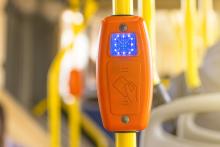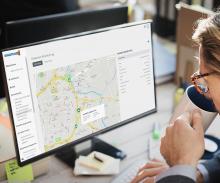
Looking back over the past 10 years it is incredible how much has changed, from the emergence of increasingly powerful smart devices, 5G and real-time social media to ride hailing, micromobility, electric vehicles and Mobility as a Service (MaaS). We’ve certainly taken a huge leap forward, much of which we now take for granted. The rise of artificial intelligence (AI) and Big Data is allowing large amounts of information to be processed, analysed and acted upon, opening the door to greater interconnectedness and innovation in transport.
Technological advancements
The next 10 years will see technology advance at an increasingly rapid pace particularly due to convergence. As engineer, physician, and entrepreneur Peter Diamandis, said in one of his recent articles: “Over the next decade, waves of exponential tech advancements will stack atop one another, eclipsing decades of breakthroughs in scale and impact.”
We believe these seismic shifts will play a fundamental role in shaping the future of MaaS, which will become much more personalised and go far beyond simple user-determined transport preferences such as speed, comfort, price and CO2 trip cost. The humble trip planning application will transform into a highly intelligent personal mobility assistant.
AI-based MaaS will more closely reflect individual habits and behaviours, taking into account health, age, accessibility needs, situation, context and many other personal profile attributes. Alongside text, voice and gesture, augmented reality will allow users to interact with MaaS in new ways, for example, navigating a person to a platform and their connecting transport. It is likely that users won’t have to enter an address into their smart device either as the system will already know where they are headed.
The rise of the Internet of Things (IoT), including smart sensors, 5G and Big Data, will also be a game changer for transport and MaaS. Sensors can detect which carriages have fewer passengers, which can help people on the autism spectrum for example, or those who are anxious in confined spaces to feel more confident when travelling. We put this to practice in our trial with Autism CRC and Transport for New South Wales in Australia.
Increasingly small, yet powerful microchips will continue to influence the capabilities of our smartphone, smartwatch or other connected device and 5G networks will provide high data-transfer speeds and low latency to support shared, connected vehicles which will become increasingly automated.
AI and machine learning algorithms will help to better understand a user’s travel preferences and behaviours as well as automating transport service improvements, delivering more tailored and smarter journey recommendations.
Predictive maintenance could foresee when transport is about to malfunction, with the traveller alerted to alternative route or mobility options, connecting them with the best services - even automating service choice based on previous behaviours or current situation and taking payment from their virtual wallet for a seamless process. As our cities and transport become smarter, so too will MaaS.
Need for open data
Standardised open data will be key to the evolution of MaaS over the next decade. It will support greater collaboration, innovation and scalability which will ultimately lead to a superior user experience and wider adoption of MaaS. Big Data will require AI and machine learning to analyse, understand and make predictions, providing accurate information and solving mobility challenges far faster than any human being. Machines will be able to ‘learn’ and find patterns based on rich data from individuals, mobility operators, sensors, past experience and environmental factors such as terrain, accessibility and weather conditions. This will allow for real-time adjustments with dynamic routing, pricing, traffic light changes and predictive traffic reports so transport can be rerouted or reallocated to reduce congestion.

MaaS will increasingly integrate a wider variety of sources which machine-learning algorithms will process alongside contextual data such as time of day, calendar, location, behaviour and situational information. It will also help to reassure passengers about their health and safety post-Covid-19. When were carriages and toilets last cleaned? Which areas of a carriage are less crowded? Scooters and bicycles - whether docked, undocked or free-range - are seeing a resurgence and will continue to provide alternatives to busy public transit.
Mobility operators will gain better insight into commuter behaviour and asset management distribution enabling them, for example, to optimise public transport, on-demand buses and e-mobility, as well as avoid disruptions or delays. MaaS will centre heavily around user experience with accessibility a critical component, helping to guide partially-sighted people to their destination, notify if ramps and support are available for those less able or if routes are cycle- and wheelchair-friendly.
Retail, leisure and events data are also likely to be part of the mix - not only providing information on directions, parking and payment but also tickets, entertainment, lifestyle and support for social collaboration with friends and family. Organising events and meet-ups, booking restaurants, synchronising calendars and changing plans on the fly, all the while communicating with other group members.
Geo-targeted promotions and discounts could be presented to the traveller either pre- or in-journey. The ability to build on top of MaaS platforms and combine data in new and meaningful ways serves to make mobility a more integrated experience, connecting people as well as places. All of this, however, will require the cooperation of stakeholders to provide high-quality, clean data that is readily accessible to ‘train’ neural networks and provide accurate intelligence for MaaS to reach its potential including ‘making decisions’ - with or without human intervention.

What makes MaaS such a powerful tool is its ability to take the complexity out of transport and travel - both for the user as well as transport authorities and mobility providers. AI and machine learning will be the glue that allows this to happen. After all, MaaS knows no borders when it comes to innovation; it is on a firm trajectory to becoming a fully-fledged personal mobility assistant that is more experiential and social. As technology changes, and our access to it increases across the globe, by 2031 MaaS will pave the way for new opportunities that reflect how people live their lives and move around, making our cities more liveable and our people happier and healthier - as well as helping to protect our planet.
ABOUT THE AUTHOR:
John Nuutinen is CEO of SkedGo
MaaS & sustainable transport systems
MaaS has an important role to play in supporting a more sustainable future, too. The next decade will see even greater pressure on the transport sector to reduce its environmental impact, particularly given it accounts for around a quarter of energy-related carbon dioxide emissions. Increasing traffic congestion, noise and pollution are placing an untold burden on our transport systems and cities.
Government measures such as low emission and car-free zones have so far been implemented alongside micromobility, electric buses, new cycle lanes and campaigns to promote active travel. Global net-zero carbon targets will require more sustainable transport infrastructure and a shift in user behaviour.
Raising awareness around the environmental impact of individual transport choices and tracking CO2 emissions over time is a vital first step. MaaS supports this aim, allowing transport authorities to prioritise low-impact travel. For instance, MaaS can incentivise users with rewards and recognition when they opt for more sustainable modes of transport. This has the advantage of encouraging users to make behavioural shifts in return for monetary or other benefits, such as free rides and eco points while businesses gain greater visibility with prospective customers and raise their green credentials.
For governments, MaaS will help to reduce congestion in urban areas and support environmental goals and targets. Policies and legislation will increasingly focus on sustainability over the next decade; private car use will be made less attractive and even more difficult (if not impossible) within cities. This will drive more users to MaaS given its ability to aggregate all available transport onto one smart device and make navigating a growing plethora of transport options easier and potentially more cost-effective.










